Vortex Movement
Table of Contents
31. How individual planets are carried along.
Let S be the Sun. All the air-aether surrounding it moves in the same direction, from A through B towards C.

This assumes the north pole rises above the plane of this figure, so that the air-aether around Saturn takes almost 30 years to carry it through its entire circle ♄.
Whereas the air-aether around Jupiter carries it through its circle ♃ within 12 years along with its satellites.
Thus:
- Mars completes its circuit in 2 years
- Earth with the Moon completes its circuit in 1 year
- Venus in 8 months
- Mercury in 3 months
They are all carried by the air-aether in their respective circles.
32. How sunspots are also carried
Likewise, certain opaque bodies, visible to us with telescopes and called sunspots, which are contiguous to the Sun’s surface, circumnavigate it in 26 days.
33. How the Earth is also carried around its own center, and the Moon around the Earth
There are smaller vortices within this greater vortex of the air-aether:
- one has Jupiter at its center, as the Jupiter vortex
- another has the Earth at its center, as the Earth vortex.
These move in the same direction as the greater vortex.
The Jupiter vortex carries around it 4 of its satellites at such speeds that:
- the farthest completes its circuit in 16 days
- the next in 7 days
- the third in 85 hours
- the one closest to the center in 42 hours.
Thus, they make several smaller circuits around Jupiter while being carried once around the Sun in the greater circle.
Similarly, the Earth vortex causes the Moon to orbit it in a month, while the Earth itself completes a full rotation around its axis each day.
In this way, after the Earth vortex goes around that great circle:
- the Earth has rotated 365 times around its center
- the Moon has revolved 12 times around the Earth.
34. The motions of the heavens are not perfectly circular.
All the centers of the planets do not always remain accurately in the same plane.
The circles they describe are not entirely perfect.
Instead, they are approximately such, and continually change over the centuries, as we see happening in all other natural things.
35. On the deviation of the planets in latitude.
The “plane of the Ecliptic” is the plane in which the Earth’s center moves throughout the year.
- This is determined in the heavens by the fixed stars.
Each of the other planets also moves in some other plane. They are somewhat inclined to this one.
They intersect it in a line that passes through the Sun’s center so that the Sun is found in all these planes.
For example, the orbit of Saturn now intersects the Ecliptic in the signs of Cancer and Capricorn, but rises above it, that is, inclines towards the north in Libra, and descends below it towards the south in Aries, with an inclination angle of about 2½ degrees.
Likewise, the orbits of the other planets intersect the Ecliptic in different places.
But the inclination is smaller in Jupiter and Mars, about one degree greater in Venus, and greatest in Mercury, being nearly 7 degrees.
Scheiner S.J.’s diligent observations on Sun Spots seem very accurate.
The spots revolve around the Sun in planes inclined by 7 degrees or more to the Ecliptic. In this way, their motion does not differ from the motion of the planets.
The Moon also revolves around the Earth in a plane that deviates by 5 degrees from the Ecliptic.
The Earth revolves around its own axis in the plane of the Equator, deviating by 23½ degrees from the Ecliptic, carrying with it the plane of the Equator.
These deviations of the planets from the Ecliptic are called motions in latitude.
36. The motion in longitude
Their revolutions around the Sun are called motions in longitude.
They also deviate in that they do not remain equidistant from the Sun at all times.
In this era, Saturn is farther from the Sun in Sagittarius than in Gemini, by about 1/20 of its distance; Jupiter is farther in Libra than in Aries.
Similarly, other planets have their aphelia and perihelia in different locations.
However, after a few centuries, all these positions will change.
Each planet, including the Earth, will intersect the plane in which the Ecliptic is now located in different places and will deviate slightly more or less from it.
Their maximum and minimum distances from the Sun will be found in different signs.
37. All phenomena can be easily understood through this hypothesis
I do not need to show from this hypothesis how the following happen:
- day and night
- summer and winter
- the Sun’s approach to and retreat from the Tropics
- the phases of the Moon
- eclipses
- stations and retrogradations seen in the Planets
- the precession of the equinoxes
- variation in the obliquity of the Ecliptic
- similar things
These will be easily understood by those who have learned the basic elements of Astronomy.